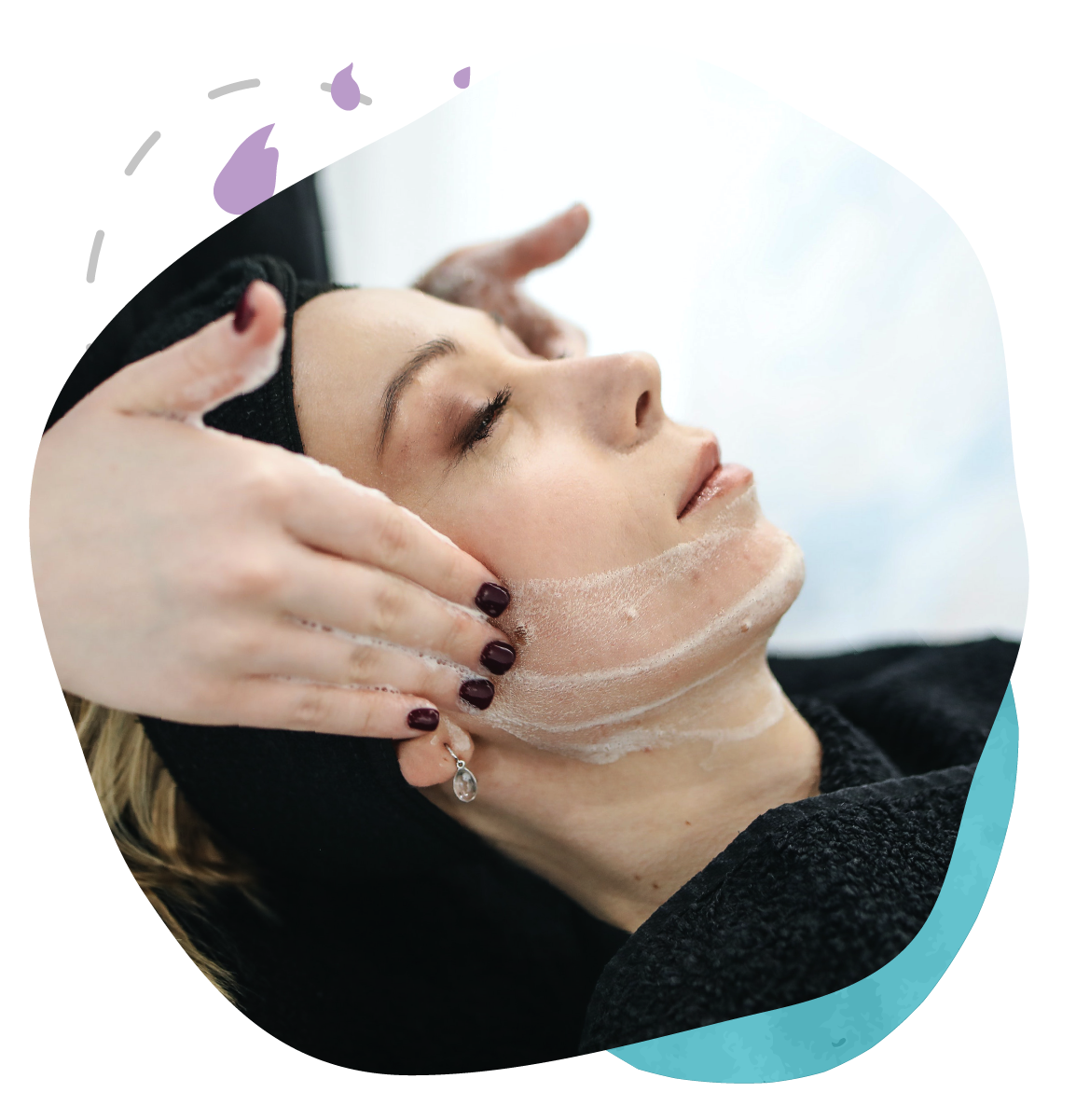
It is a holistic, non-invasive technique that utilizes massage strokes such as kneading, effleurage and lymphatic drainage to stimulate the facial muscles.
What is
Face Massage Therapy?
It is a holistic, non-invasive technique that utilizes massage strokes such as kneading, effleurage and lymphatic drainage to stimulate the facial muscles.
Face massage therapy has been around for centuries, and this healing practice can be traced back to ancient Egypt. It is a holistic, non-invasive technique that utilizes massage strokes such as kneading, effleurage and lymphatic drainage to stimulate the facial muscles. It helps improve circulation, release tension from specific areas, and increase blood flow to key points in the face. This leads to increased collagen production for smoother skin, firmer contours, and a more youthful appearance overall.
What Can Face Massage Therapy Treat?

Face massage therapy can be used to treat a variety of conditions and ailments. It is particularly effective in treating:
- Wrinkles and fine lines
- Dark circles and eye puffiness
- Acne and blemishes
- Sagging skin
- Head and Shoulder Posture
- Headaches
- Migraines
- Sinusitis
- Sinus pressure
- Poor Circulation
- TMJ disorder (pain in the jaw joint)
- Neck and shoulder tension
In addition, face massage therapy can help reduce stress, alleviate anxiety and depression, and improve overall well-being.
Understanding How Face Massage Therapy Helps Common Symptoms
While the results may vary based on the individual, face massage therapy can provide relief and improve the appearance of many common symptoms.
Wrinkles and fine lines
Wrinkles and fine lines are a natural part of aging due to reduced collagen and elastin and decreased skin cell turnover. Poorly hydrated skin, unprotected sun exposure, and unhealthy lifestyle habits such as too much alcohol or smoking increase wrinkles. However, face massage therapy may help combat these signs of aging. Techniques used in facial massage therapy can include stroking, kneading, tapping, rolling or cupping. These techniques stimulate cell regeneration and collagen production while also draining excess water and toxins from the face. The end result is a visible reduction in wrinkles and fine lines.
Migraines and Headaches
Face massage therapy can help reduce the intensity and duration of headaches and migraines due to its ability to relax muscles in the face, neck and shoulders. During a face massage session, techniques may include acupressure, myofascial release, or other methods that target areas of the face and neck that are prone to tension. Acupressure is especially beneficial for headaches as pressure is applied to key points in the scalp, jawline, and temples to help reduce pain. Myofascial release techniques with knuckles or a light roller provide even more profound relaxation. This combined approach can provide tremendous relief, decrease muscle stiffness, and affect localized circulation, reducing tension-type headaches.
TMJ Disorder
TMJ disorder is a condition that can be triggered by many different factors, including excessive strain on the jaw joints and muscle groups that control chewing, swallowing, and speech. It may also be caused by malocclusion, clenching, grinding, or trauma. It often causes pain in the jaw, face, neck and shoulders. Face massage therapy can help alleviate associated symptoms such as muscle tension and stiffness. At Orofacial Myology Resolutions, we use various massage techniques around the mouth, ears, temples and forehead to target areas affected by TMJ disorder. Face massage therapy can improve mobility and reduce inflammation by relieving tension and easing pain.
Posture
Good posture is essential for health, and people across ages are increasingly lacking in it due to physical or mental stress. Long work hours, working on computers and phones, and personal entertainment activities such as scrolling through social media all contribute to aches and poor posture. Facial massage therapy helps relax the facial muscles while restoring their structural balance so that they become stronger over time. Thus, improving not just the appearance but also aiding posture-related problems throughout the body. Without proper posture, a person's health begins to suffer from pain-related problems ranging from backache to spondylitis.
Sinusitis
Sinusitis is a condition of the sinuses characterized by inflammation or infection. It can cause symptoms such as facial pain, post-nasal drip and congestion. Facial massage therapy can help reduce swelling in the face caused by sinusitis. Massage around pressure points on the nose, forehead, cheeks and jaw can help clear congestion and relieve the pain associated with sinusitis. The massage technique of applying rhythmic pressure to the sinus cavities while holding your breath may also help to improve sinus drainage.
Stress Reduction
Face massage therapy is incredibly effective for reducing stress and tension, recharging one's energy, and making one feel more emotionally balanced. Techniques such as myofascial release may be used to specifically target tight muscle spots and help promote feelings of relaxation and emotional balance. During a face massage therapy session, particular attention is paid to areas around the eyes where much of our emotional stress and physical tension are stored. Pressure is applied to key points around the eyes, forehead, temples, and jaw to help relax facial muscles and reduce any built-up tension. Stress hormones are reduced through increased blood flow to facial muscles, loosening of tightness, and free movement of fluids beneath the skin surface. At the same time, new energy channels are opened throughout the body. All this results in a positive and calming effect that helps reduce stress and promote overall well-being.
Types of Face Massage Techniques
Several techniques are used for massaging the face, depending on desired results and the symptoms being addressed. These techniques can include:
Swedish massage
This type of massage is used to relax the facial muscles, reduce tension, and improve facial circulation. Slow strokes are applied with light pressure over the entire face, allowing for a deep sense of relaxation.
Myofascial release
This technique addresses tightness in the facial muscles and connective tissue, relieving tension headaches. Pressure is applied to specific areas around the jaw, neck, cheeks, and forehead using circular motions.
Acupressure
This method involves applying pressure to specific face points associated with particular organs or meridians. It helps improve overall energy flow and releases tension in the face.
Reflexology
This involves applying pressure on particular points on the face that correspond to various organs and glands in the body. Stimulating these points helps to reduce stress, improve the functioning of the organs, and promote healing.
Trigger point massage
This technique relieves pain caused by trigger points, or knots, in the facial muscles. It is most effective in alleviating TMJ disorder-related symptoms.
Lymphatic drainage
This is a light massage technique that reduces swelling and improves lymphatic circulation in the face. Gentle strokes are applied along the nodes of the lymphatic system, helping the body detoxify itself naturally.
Explore the Benefits of Face Massage Therapy
Face massage therapy is an incredibly versatile healing practice that can benefit anyone looking to improve their overall health. Whether you are looking for relief from serious conditions such as sinusitis or TMJ disorder or simply seeking to reduce stress and tension, facial massage therapy can provide the relief you need.
With regular sessions and proper technique, you can look forward to improved circulation in your face, reduced stress levels, improved posture, enhanced emotional balance and overall better health.
Orofacial Myology Resolutions is available to help you explore the possibilities of facial massage and find the best treatment for your individual needs.
Book An Appointment
Contact us today to book an appointment and get started on your journey toward optimal health and well-being.

Face Massage Therapy Frequently Asked Questions:
-
Is face massage therapy painful?
Most face massage techniques are designed to be gentle and soothing, so they should not cause any pain. If you feel any discomfort during your session, communicate this to your massage therapist so they can adjust the pressure accordingly.
-
How often should I schedule face massage therapy sessions?
The frequency of treatments depends on your individual needs and the symptoms you are looking to address. Generally, it is recommended to have regular treatments for you to see the best results. You can discuss this with us and decide on a treatment plan that works for you.
-
What type of face massage techniques do you use and is it painful?
We use various massage techniques depending on your needs and the symptoms you want to address. Generally, these techniques are designed to be gentle and soothing so they should not cause any pain. Some of the most commonly used methods are myofascial release, acupressure, lymphatic fluid drainage, reflexology and trigger point massage. If you feel any discomfort during your session, communicate this to your massage therapist so he or she can adjust the pressure accordingly.
-
What are the main benefits of face massage therapy?
Main benefits of face massage therapy include improved blood circulation, reduced stress, improved posture, enhanced emotional balance, relief from sinusitis and TMJ disorder-related symptoms, along with a general feeling of relaxation.

